Pros
Cons
Testing / Performance
To test the color accuracy of the Fujifilm FinePix A330, we took a series of exposures of a GretagMacbeth color chart and ran the images through Imatest Imaging Software. The software reads the images to determine the accuracy of each tone and the degree in which it varies from the ideal. The chart below portrays the results; for each color tile, the exterior square is representative of the actual tone produced by the camera, while the inner square is the camera’s produced tone corrected by the software and the small vertical rectangle in the center is the ideal.

The graph below depicts the 24 tones rendered by the FinePix A330 and the extent in which each strays from its ideal. The circles are the colors produced by the camera, while the correlating squares are the ideal. The length of the line connecting the two is the degree of error. When the square is further towards the edge of the frame, the tone is over-saturated; conversely, when the circle is closer to the center of the graph, the tone is duller than the ideal.
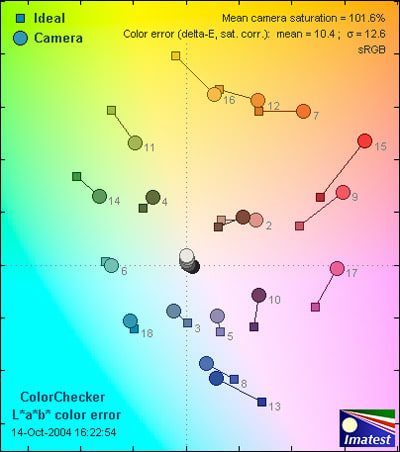
In terms of overall color performance, the FinePix A330 did not perform well, receiving a 4.76 overall color score. With the exception of the "cyan" #18 and "bluish green" #6, nearly all of the tones strayed from their targeted hue. Often cameras will over-saturate all of the tones to gain more vivid colors with greater overall intensity; however, the degree of error in each of the tones produced by the A300 is not consistent. While consistent error will not provide a realistic rendering of the scene, it will act as a form of color balancing, creating a scene that the eye can adapt to. However, when there is such a wide discrepancy between the various tones, the error in each color is emphasized, creating a scene that does not look correct to the human eye.
The 101.6% mean saturation score the A330 received is not terribly high; however, the reason for this is again attributed to inconsistency. While "green" #14, "yellow green" #11, and "yellow" #16 are all significantly duller then the ideal, the A330’s rendering of "red" #15, "moderate red" #9, "magenta" #17, and "purple" #10 are all substantially over-saturated. The over-saturated tones can be attributed to Fujifilm’s attempt to emphasize the colors that impact skin tone, as many other point-and-shoot cameras do to gain a slightly embellished, glorified rendering of people; however, there is no clear justification for the dull tones. Unfortunately, this discrepancy results in images that are tonally inconsistent and disconnected from the original color balance of the scene, making images appear awkward and unnatural.
**Still Life Scene
**Below is a shot of our fancy still life scene taken with the Fujifilm FinePix A330.
[

Click on the above image to view a full resolution version (CAUTION: The linked file is VERY large!)](../viewer.php?picture=Fuji-FinePix-A330_LGStillLi.jpg)
**Resolution/Sharpness ***(1.97)*
We test the resolution of each camera using an ISO resolution chart and Imatest Imaging Software. The software is used to determine the "actual resolution" within a recorded image. While today’s digital cameras are often sorted by their megapixel count, these numbers can be quite deceiving. A camera’s marketed resolution is a reflection of the largest image size the camera is capable of producing; however, most cameras stray significantly in the actual pixels utilized within the recorded frame. Therefore, it is necessary to understand these numbers in a new light. We do this by contrasting the recorded pixels with the projected pixel count to get a percentage score of the camera’s resolution. Cameras which record images at 70-79% of their projected megapixel count are considered to be "good" performers, while a camera that scores 80-89% is viewed as "very good" and any camera that exceeds 90% is "excellent."
The Fujifilm FinePix A330 recorded images with 1.97 "actual" megapixels, which is just over 65% of its marketed resolution. While the total megapixel count is not overwhelming, the more discouraging aspect of the score is that the A330 only recorded 65% of the projected megapixels. This is disappointing regardless of the grade or styling of the camera. While more megapixels does not necessarily equate to a better camera, a certain amount is necessary to attain decent images with crisp detail and sharp accents. Obviously, when larger prints are sought, more megapixels are needed to maintain sharpness, though for prints 8 x 10 and below, 3.0-3.5 megapixels should be adequate. Therefore, with the FinePix A330’s 1.97 megapixels of resolution, it will be difficult to produce substantial size prints with any definition and the user should really stay within the 4 x 6 range.
**Noise Auto ISO ***(4.18)*
The FinePix A330 is made with a fixed ISO speed of 100. This is puzzling as most automatic point-and-shoot cameras contain an ISO range regardless of user control options. The single setting substantially restricts shooting flexibility as the A330 user will either have to shoot exclusively under profuse lighting or will have to be married to the flash. The included stock flash will provide enough illumination to expose most subjects at short distances; however, all of the images will contain the harsh, straight-on glare of direct lighting, without opportunity for alteration. ****
**Noise Manual ISO ***(0.0)*
The A330 is intended for the point-and-shooter and is designed to provide automatic imagery with little effort. Therefore, no manual ISO settings are included on this model.
**Speed/Timing
***Start-up/First shot (6.28)
*Boot-up time on the A330 takes 3.72 seconds to fully power on and record an image. This is relatively slow and definitely will not provide the instantaneous response time some photographers demand in recording a fleeting moment. Therefore, if it’s quick responses and immediate imagery you are after, another camera may be a better fit.
Shot to shot (7.57)
Shot to shot time is far faster on the A330 than its initial start-up. Taking 2.43 seconds between shots, the A330 grants substantial speed for the snapshot shooter and should meet the needs and demands of most of its users as it also contains a burst mode that will record images at 1.5 frames per second when added speed is necessary.
**
Shutter to shot (8.48)
From the time the user depresses the shutter release to the time the image is captured takes .26 seconds on the A330. This is quite fast for nearly all cameras and will help to minimize unwanted movements and stray objects from seeping into the shot as it is recorded.
Physical Tour
**
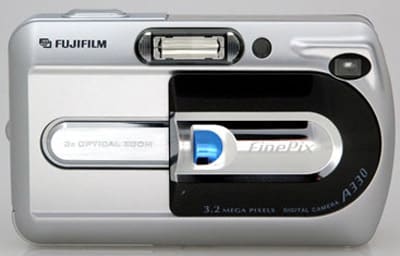
Front (5.5)
**Sleek, silver, and flat, the shape of the Fuji FinePix A330 is very similar to some of its competitors. As with the Canon PowerShot A310, the FinePix A330 has a sliding lens cover that turns the camera on and off, although the Fuji’s is admittedly less chic due to the fact that it’s plastic and multicolored. Unlike many other cameras, the FinePix A330 has an aesthetically condensed, almost cluttered appearance. Its chrome-like lens cover dominates the front of the camera and has multiple shades in it, while the flash and red-eye/self timer light and minuscule viewfinder are squished in as an afterthought, slightly above and to the left of the fixed Fujinon 3x optical zoom lens.
**
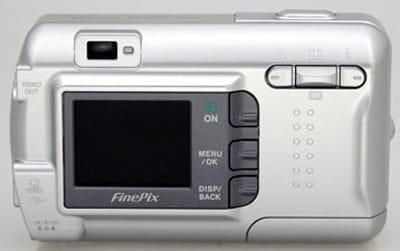
Back *****(7.0)
***Unlike the front of the camera, the back is refreshingly straightforward. On the left-hand side is the 1.5-inch LCD screen, with playback, menu, and display buttons running vertically down the right side of it. On the upper left of the camera is the impractically small viewfinder, and slightly to its right is a viewfinder LED lamp that lights up green, orange, or red to indicate battery life, storage activity, flash readiness, and sleep mode. Three buttons on the upper right act to control macro mode, zoom and flash mode. When in playback and menu mode, these buttons function to scroll quickly up and down as well as left to right. On the right-hand side of these are small bumps and a ridge along the side of the camera to help grip.
**
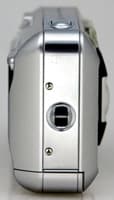
Left Side (6.5)
**The left side of the A330 contains three sockets for connectivity, all clearly labeled: a video out socket, a USB port for file transfer, and DC input for an AC power adapter (sold separately). The USB socket also acts as a port to connect the camera, when tilted on its side, to a dock (also sold separately).
Right Side*(6.5)*
There isn’t much on the right side of the camera except a small mount for a hand or neck strap.
**

Top (7.0)
On the top of the camera is the shutter, which not only takes the picture but, when pressed halfway, acts to engage the auto-focus and focus-lock. **
Components
Viewfinder ***(2.5)***
It is clear when using the viewfinder on the FinePix A330 that its ridiculous size and location makes it more of a novelty and less of a functional addition. As is the case with most digital point-and-shoots, the LCD screen is presumed to be the primary method of viewing and composing shots, so it is no great surprise that the viewfinder has gotten so little respect. Nevertheless, if it’s going to be included at all – and shouldn’t it?-- it ought to be functional.
LCD Screen ***(5.0)***
The LCD screen on the FinePix A330 contains 60,000 pixels, which is inadequate even for a lower-end camera. Although the screen does span 1.5 inches, which is sufficient for composing an image (given appropriate lighting) and navigating through thumbnails and menus, the resolution may prohibit good visibility and cause some difficulty in viewing.
Flash ***(7.5)***
There are six different flash modes available on the FinePix A330, although which ones are available depends on the chosen shooting mode. The manual mode gives the most options, obviously, allowing for Auto, Red eye reduction, Forced flash, Suppressed flash, Slow sync, and the Red eye + slow sync combination. Forced flash can be thought of as a "fill light," and suppressed flash is good for situations like shooting through windows where there might be a reflection. Night shooting mode allows for only slow sync, suppressed flash and slow sync + red eye modes, illuminating the subject while using a slower shutter speed (up to two seconds) to let ambient light in. All flash modes are possible in the portrait mode, whereas none are possible in the landscape mode, and the sport mode allows only auto flash, forced flash, and suppressed flash modes. I can understand that each preset shooting mode was designed to simplify certain shooting situations, but wouldn’t it be less confusing just to offer all flash modes for each shooting option? At least the modes are easy to toggle through by pressing one of the top three navigating buttons.
Zoom Lens ***(7.0)***
The Fuji FinePix A330 comes with a non-interchangeable lens that has a 3x optical zoom and a 1.7x digital zoom. This is equivalent to a traditional 35mm lens of 38mm-114mm, which is more than enough to satisfy the average user.
Design / Layout
**Model Design / Appearance ***(7.0)*
At first glance, the Fuji FinePix A330 appears flashier than some of its competitors. It’s cast in gleaming silver plastic and metal, with a front dominated by a chrome sliding lens cover. Fortunately, the back of the camera is somewhat less gaudy and more practical, containing well-labeled buttons in a simple arrangement; positioned within thumb’s reach. A user can navigate the six buttons by touch, without fumbling or pressing multiple controls at once. Those who are used to a larger bodied camera with a substantial frame might find the A330 awkwardly small to grasp, although its long, narrow design makes it ideal for a child’s hands. Yet, despite its shiny plastic front and minimal size, the camera doesn’t feel like a toy. The FinePix A330’s solid construction and user-friendly navigation make it an attractive and affordably priced point-and-shoot camera for digital newcomers.
Size / Portability*(7.0)*
Weighing in at 6.8 ounces, the FinePix A330 is on the lighter side for its class, considering its size of 4.1 x 2.4 x 1.2 inches. While small and light enough to take on vacation, the FinePix A330 is more likely to fit in a purse or backpack than in your pocket. For those who want the kind of camera you can carry around effortlessly to capture spontaneous moments, or take to the bar in a coat pocket, this camera isn’t it; however, for the majority of users, who don’t wish to be bothered with a camera bag yet don’t need something itty-bitty, this camera will certainly do.
**Handling Ability ***(6.5)*
The Fuji FinePix A330 is compact and feels solid in the user’s hands. With practical placement of the buttons, the camera can be easily managed with one thumb. While this well-conceived layout is much appreciated and useful, one must also take into consideration that the FinePix A330 user will probably hold the camera in both hands, using the LCD screen to compose and control shooting. In fact, the viewfinder is so small and poorly placed that it is difficult to imagine anyone actually navigating the buttons while shooting, as you would with an SLR. The light weight of the camera is substantial enough, helped out by its textured surface and small ridge on the far right side to help give its flat shape a better grip. I do wish however that it had a little bit more height and depth on the right side to rest more securely in my hand as some of the Kodak EasyShare and Canon PowerShot series do. Overall, the Fuji FinePix A330 is a compact and maneuverable point-and-shoot camera and should provide comfortable handling and more than adequate control.
**Control Button / Dial Positioning / Size ***(7.5)*
Fuji has made navigating the controls a breeze. Keeping in mind that the user would never be pressing buttons with the camera up to their face, three elevated buttons for controlling framing are located in the upper right, near the viewfinder. The center button, which can be pushed upwards or downwards, and the left and right buttons are used for scrolling through menus rapidly. Within thumb’s reach are three more buttons near the LCD screen that control menu and playback features. These have slight ridges on each, allowing the user to find them easily by touch, and are clearly and logically labeled. The buttons are large enough and far enough apart that even the thick thumb won’t depress all the buttons at once, nor fumble to find things. My only disappointment was the sliding lens cover, which acts to turn the camera on and off. In addition to its rather flaky plastic feel, whenever the camera goes into PowerSave mode and turns itself off, which can be as quick as after two minutes of inactivity, the only way to turn the camera back on is to close it and reopen it. This gets old pretty quick. Fortunately, this is my only complaint about the controls, and the camera redeems itself with its simplistic and intuitive navigation.
Menu ***(7.0)***
The menu button on the FinePix A330 plays a dual role, controlling options both while shooting and during playback. When the menu button is selected in shooting mode, a string of icons will pop up in a layout similar to the "dock" for Macintosh users. One can scroll from left to right along the icons and, when one is selected, it is magnified on the bottom, and a box pops up with the relevant options. Using the three buttons in the upper right-hand corner, one can quickly and logically navigate from left to right and up and down these lists without ever getting lost in layers of subcategories. The menu options that come up are: quality settings, self-timer, shooting mode, and set-up. Even the set-up section is laid out in pages that are simple to navigate: Image Display, Power Save, Format, Beep, Date/Time, Time Difference, LCD, Frame Number, USB mode, Language, Video system, Discharge, and Reset.
I have only two small complaints. With each change you make in the menu mode, you are brought automatically back to the shooting mode, so if you want to make multiple changes, you need to keep returning to the menu. This can become time consuming and is quite frustrating. Fortunately, it is not as multi-layered as many digital camera options are, so it’s not hard to get back to where you want to be.
When using the Playback Mode, the menu button gives you the options of erase, DPOF (which allows you to specify print options for each frame), protect (which allows you to ‘lock’ frames from being accidentally erased), automatic playback (which allows you to choose from four different ways of presenting photos in slide show format), and trimming (which allows you to crop photos in the LCD viewfinder and save them separately). Overall, I found the icon presentation and layout to be amazingly intuitive and easy to navigate.
Ease of use ***(7.0)***
This camera’s charm lies in its simplicity. With only six buttons on the back of the camera, each clearly labeled and all within thumb’s reach, there is no unnecessary fumbling or searching. Because there aren’t many fringe features, the organized menu ensures that the FinePix A330 is a simplistic relief for any level user.
Modes
Auto Mode ***(7.5)***
As the name implies, Auto Mode gives the user a break from decision-making and pretty much takes control of shooting. There is still the option to choose image quality (1M, 2M, 3M normal, 3M fine), and Macro mode is still available. As far as the flash is concerned, the user can choose among Auto flash, Red eye reduction, Forced flash, and Suppressed flash. Focusing is the same in any mode; the shutter button is pushed halfway to activate auto focus and lock the focus.
Movie Mode (5.0)
The movie mode can be found with all the other shooting modes in the main menu of the FinePix A330, with the option to shoot JPEGs without sound at either 320 x 240 pixels or 160 x 120. According to the manual, the camera can record up to 60 seconds in the 320 mode or four minutes in the 160 mode, but that figure could be much less, depending on available memory. Although it is a nice little gadget to play with, it only records 10 frames per second.
Drive / Burst Mode (6.5)
The Fuji FinePix A330 is capable of shooting continuously at 1.5 frames per second.
Playback Mode ***(7.0)***
Just like the button layout, the playback mode on the FinePix A330 is intuitive and easy to navigate. Pressing down the playback button for one second activates the mode (which can also be activated while the camera is supposedly off, oddly enough) and photos are easily switched via the three buttons in the top right. By pressing the display button, you can toggle through viewing modes. The first has the photo info, the second has no text, and the third shows a thumbnail view with nine photos. While an image is selected, it is possible to zoom in and pan across the image from 8x up to 13x, depending on photo resolution. While in the playback mode, hitting the menu button brings up the following options: Erase, DPOF (digital print order format, which records printing specification for images), Protection (locks frames you select and protects them from being accidentally erased), Autoplay (four different slide show options can be selected), and Trimming (which allows you to resize and crop a photo and save it as a new image).
Custom Image Presets ***(6.0)***
The Fuji FinePix A330 has four different preset shooting modes besides Manual and Auto, each of which is controlled automatically by the camera, and each of which contains different flash options. The "portrait" mode is designed for reproducing better skin tones and has an overall softer tone, and all flash modes are possible. Portrait mode also minimizes depth of field to blur the background and cause the subject in front of it to stand out. The "scene" mode is designed for shooting landscapes in daylight and does not allow for any use of flash. The "sport" mode gives a higher priority to faster shutter speeds (the fastest being 1/2000) and allows only auto flash, forced flash, and suppressed flash modes. The "night" mode is the only way to take advantage of the 2 second long shutter speed, offering suppressed flash, slow sync, and slow red-eye flash modes along with it. There is also an impressive macro mode, which can be used both in manual and auto modes, that will focus as close as 3.9 inches from the lens (according to Fuji), though I managed to focus even closer than that.
Overall, I think the presets fit the bill; however, at some point, even beginners will want to expand. For this reason, I would have appreciated options for shutter and aperture priority in addition to the more basic presets, or at least something as simplified as the Canon PowerShot A80’s "slow" and "fast" shutter speed.
Control Options
Manual Controls
Manual Control is again quite limited on this camera; however, the image quality and size are selectable as well as the six flash modes a user can choose from (Auto, Red-Eye Reduction, Forced Flash, Suppressed Flash, Slow Synchro, and Red Eye + Slow Synchro). Flash mode is the only shooting mode that allows for control over Exposure Compensation and White Balance (of which there are seven presets to choose from).
Focus
***Auto Focus(6.5)*****
The Fuji FinePix A330’s auto focus is relatively basic, relying on the center box displayed on the LCD as the designated focal point. In order to focus on something that is not located in the direct center of the frame, there is the AF lock, which is operated in much the same way as auto focusing except that you place the object you want in focus in the center of the frame, use auto focus, and you are then free to compose the frame as you wish while the subject remains in focus.
Manual Focus*****(0.0)*****
The FinePix A330 is designed for entry level and amateur photographers, many of whom are not as concerned with manual control as effortless precision. Therefore, it is not surprising that all focusing on the FinePix A330 is done automatically, sacrificing control for simplicity.
Metering ***(6.5)***
Taking into consideration that this camera is aimed at amateur photographers, once again control has been sacrificed for simplicity. The camera’s automatic metering uses a TTL 64-zone system, and when in unusual lighting situations, it is always possible to use the exposure compensation (in manual mode) to adjust for differences.
Exposure ***(6.5)***
In any mode except for manual, the exposure is controlled automatically by the FinePix A330. In difficult lighting situations, such as backlighting, the Exposure Compensation feature can be very useful. Through the menu, users can adjust the meter reading from -2.1 EV to +1.5 EV in 0.3-step increments. I’m not sure why it is not an even -2 EV to +2 EV, which would make more sense, but nonetheless the FinePix A330 allows for exposure adjustments.
White Balance ***(6.5)***
White Balance control is only available in manual mode and is perhaps the most in-depth custom feature that the camera has to offer. White balance is used to correct color and acclimate the scene to a variety of light sources. Given the various temperatures and colors of light, the white balance option is necessary to orient the camera to "true white" in the given shooting situation. Therefore, a list of seven potential lighting situations and settings are provided to fit the needs of the scene: auto, outdoors/fine weather, outdoor/shade, "daylight" fluorescent lamps, "warm white" fluorescent lamps, "cool white" fluorescent lamps, and incandescent light. I am pleased by the extensive list of options and even more pleased with the method of selection that the camera provides. When selecting the desired white balance control, the camera’s LCD continues to display the "live image" in the background as you toggle through the selections, providing a preview of the alteration to the image as the setting is reached.
ISO ***(0.0)***
Keeping in mind that the FinePix A330 is geared towards amateur photographers, the amount of control over ISO is limited. The speed is fixed at 100, which is fine for outdoor shots, but is rather limited in low light situations, forcing the user to rely on the flash. If the main purpose of this camera is to take snapshots of the kids playing soccer or macro shots of flowers under profuse lighting, you will be more than satisfied. But if you would rather have control over ambient light, or know you will be doing a lot of shooting indoors and don’t want to use flash all the time, you might want to consider a higher-end camera with more options.
Shutter Speed ***(0.0)***
With a shutter speed range of 2 seconds to 1/2000 of a second, the FinePix A330 can cover a lot of ground. Although it cannot be set manually, certain shooting modes give priority to shutter speeds. For example, the night shooting mode takes advantage of the slow shutter speed and will slow-synch the flash so the background and foreground are both well exposed. Those who are interested in shooting action scenes will be pleased to know that the sports shooting mode gives priority to fast shutter speeds with a top speed of 1/2000, which is rapid enough to freeze fast motion. Although it would be nice to have the possibility to do exposures of 10 or 15 seconds, I think that most users should be satisfied with the results of a two second night shot with flash.
Aperture ***(0.0)***
While there is no manual mode for controlling aperture, the lens’s wide angle range is from f/2.8-f/4.8 while telephoto is f/5.6-f/9.5. If you are the kind of person who wants to use depth of field creatively or control the backgrounds of your compositions, you will feel restricted. On the other hand, if you just want to take a picture, and take it fast with no worries, this camera will effectively handle the aperture opening for you.
Image Parameters
**Picture Quality / Size Options (7.0)**
The picture quality choices available to the Fuji FinePix A330 are 3M, 2M, 1M (2016 x 1512 pixels, 1600 x 1200, and 1280 x 960, respectively). The quality choices can be found in the menu under any shooting mode. When in movie mode, two different size options are available: 320 x 240 pixels and 160 x 120.
Picture Effects Options ***(0.0)***
The Fuji FinePix A330 has no preset picture effects. Other cameras in this price range, such as the Canon PowerShot A400, include vivid-color, neutral, low sharpening, sepia, and B&W color options. While in-depth, funky effects aren’t necessary, I think that black and white, sepia, and vivid-color options are required at this price point and are appreciated by those who don’t want to spend time on the computer tweaking their photos. For the target audience, it would have been a nice inclusion.
Connectivity / Extras
Connectivity
Software (6.0)
Included in the Fuji FinePix A330 is a CD-ROM with FinePix Viewer and ImageMixer, both of which support Windows and Mac OS formats.
Jacks, ports, plugs (6.0)
The three ports for connectivity can all be found on the left side of the camera. They’re conveniently labeled on the back of the camera: a video out socket that allows you to connect the camera to a TV, a USB socket for file transfer and the possibility to print directly from the camera, and lastly a DC input for an AC power adapter (which is sold separately). The USB socket also acts as a port to connect the camera, when tilted on its side, to a dock (also sold separately).
Direct Print Options (6.5)
The Fuji FinePix A330 calls its direct print option the "PictBridge function" and is operated by connecting the camera and printer directly through USB ports. By navigating the menu on the LCD screen, one can take advantage of frames pre-selected by the DPOF function (which records printing information on each frame) to print frames with date info. Without using the DPOF function, you can still print directly, but you must go through each frame one at a time and select the number of copies.
Memory (5.5)****
The Fuji FinePix A330 comes with a 16MB xD-Picture Card, which can hold up to 33 pictures at the lowest resolution setting, 10 at the highest setting, 98 seconds of high-res movie, or 5.6 min of low resolution movie. At first glance, this may seem like a lot, but essentially, even one brief movie can take up most of the memory card, and before you know it, you have to start choosing which photos you are willing to trash to keep shooting. Frankly, I can’t imagine straying more than ten feet from the camera dock without a larger memory card.
Other features ***(3.0)***
One of the convenient accessories which is NOT included in the FinePix A330’s package is the PictureCradle, which, similar to other point-and-shoot cameras, acts as a dock. By connecting the USB cable and AC power, you can pop the camera in on its left port side and charge a rechargeable battery (included with PictureCradle) while transferring files to your computer.
Overall Impressions
Value ***(6.0)***
In general, the Fuji FinePix A330 stands up to its competition in the lower price bracket, delivering quality photos at an accessible price. It is comparable to other point-and-shoot cameras on the market in terms of its resolution capabilities, zoom and flash range, and relatively simplistic controls. It is weaker than its competitors in terms of its movie speed and lack of color modes, and may not offer the opportunity for growth that some other financially equitable models provide.
Comparisons
[*
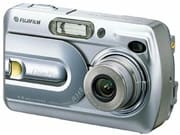
Fuji FinePix 340*](../specs/Fuji/FinePix%20A340.htm)–Distinguishable on the exterior only by the color of the plastic lens cover, the 340 is the A330’s superior, but not by much. The only noticeable difference is a 4 megapixel CCD (compared to the A330’s 3.2M) and a 1.7x digital zoom (compared to 1.6x)–and of course, the price, with an MSRP of $199 (compared to $179).
*
*[
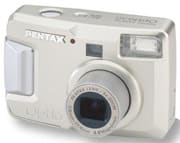
Pentax Optio 30](../specs/Pentax/Optio30.htm)–Also with an MSRP of $179, the Pentax Optio 30 has comparable resolution of 3.2 megapixels, an identical zoom range (38mm-114mm) and the same limited exposure control. For the custom preset enthusiast, the Optio 30 contains many more shooting modes, such as surf and snow, flower, party, food, and pet – leaving us to wonder if there is any possible situation not simplified down to a button. The Optio 30 also features selectable ISO ratings (50, 100, 200, 400), and different autofocus modes (5 point, spot AF and infinity landscape mode). Although still not ideal, the Optio 30 offers a movie mode slightly faster than the FinePix A330’s, running at 15 fps. As a bonus, the Optio 30 is also smaller and lighter (3.7" x 2.4" x 1.4" at 4.6 oz.) and contains a built-in 16MB memory.
[*
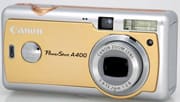
Canon PowerShot A400*](../content/Canon-PowerShot-A400-Digital-Camera-Review-.htm)–Another camera in the same price range as the A330 at roughly US $179 is the PowerShot A400, containing 3.2 MP of resolution, with a 2.2x optical zoom and 3.2 digital zoom (equitable to 45-100mm on a 35mm camera). In most respects, the A400 is similar to the FinePix A330, with a few exceptions: color modes (vivid, neutral, low sharpening, sepia, black and white), and a more complex auto focusing system, with either nine-point or center AF. While it offers fewer flash modes than the FinePix A330, the A400 has more exposure modes, such as Evaluative, Center-weighted, and Spot, as well as more shooting modes. Externally, the A400 resembles the FinePix A330’s long sleek silver design, although it is more compact, being both slightly smaller and lighter (4.2" x 2.1" x 1.4" at 5.8 oz.) Though neither will likely appeal to true movie buffs or videographers, the PowerShot A400 will record motion video at 15 fps with audio.
[*

Nikon Coolpix 2200*](../specs/Nikon/CoolPix%202200.htm)–For the real budget buyer, the Coolpix 2200 has an MSRP of $149 with a sacrifice in resolution at 2 MP. Similar in shape to the FinePix A330, the Coolpix 2200 is 4" x 2.6" x 1.5" and weighs 6.2 ounces. With a 3x optical and 4x digital zoom (36-108mm 35mm equivalency), the A330 provides slightly more telephoto opportunity than the Coolpix 2200, while the Coolpix 2200 offers slightly more on the wide angle side. The Coolpix 2200 will record video in movie mode at 15 fps, and contains scene modes for an abundance of shooting situations. The Coolpix 2200 has a lot to offer in terms of customized modes and settings and may be more ideal for a beginner. Color modes like vivid, Black & White, sepia, and cyanotype are offered, along with a built-in 14.5MB memory, making the Coolpix 2200 a bargain.
Who It’s For
Point-and-Shooters - For all those point-and-shooters out there who just want a quality snapshot right out of the box, avoiding the manual and long menus for features that are not imperative, this camera’s for you. The FinePix A330 is straightforward in its design and delivers a quality image with no frills attached.
Budget Consumers - The FinePix A330 is a great camera for the budget consumer who doesn’t need all the bells and whistles, but rather just prefers a foolproof, quality snapshot. If you’re looking for more manual control, however, you can expect to fork out a lot more cash. Of course, all you point-and-shooters out there that are buying this camera to replace your latest disposable camera can indulge in its simplicity and take delight in the economic returns it will accumulate.
Gadget Freaks - If you’re going for the kind of camera that’ll wow your tech-savvy friends, this camera might not be the best choice. The FinePix A330’s charm is in its simplicity; it gets the job done with no fuss or fumbling. If you’re hell-bent on bells and whistles, then this camera will not do.
Manual Control Freaks - Manual control freaks be warned: while there is a manual mode, this does not provide the possibility to set shutter speed or aperture, nor focus manually. At most, you can choose which kind of flash setting you want, use white balance, and compensate exposure, but that’s about it. You’re not going to get the control you want in this price range, and you certainly won’t find it here.
Pros/Serious Hobbyists - Similarly, if you feel the need to have complete artistic control over each shot, and feel restricted by simplified automatic controls, you certainly need to move on to a higher-end camera. The FinePix A330 is meant to take the complication of out shooting, and this inevitably sacrifices control.
Conclusion
Conclusion
The Fuji FinePix A330’s asset is that its sheer simplicity makes it accessible to any level of shooter. It's a dream come true for digital débutantes or anyone searching for a camera that will do the thinking for them. If you want to take a quality snapshot with no hassle or learning curve, this camera is for you. However, for amateurs looking to learn and experiment with their equipment, this camera leaves little room for exploration or growth. You have to be realistic when looking at this camera; keep in mind that it is one of the less expensive digital point-and-shoots on the market, with an MSRP of $179.00. Accepting the camera in its simplicity, the FinePix A330 is a pretty solid package and is sure to satisfy appropriate users.
Specs
Specs Table
{{manufacturer_specs_table}}{{raw_scores_table}}
Meet the tester

Christina St. Pierre
Editor
Christina St. Pierre is a valued contributor to the Reviewed.com family of sites.
Checking our work.
Our team is here to help you buy the best stuff and love what you own. Our writers, editors, and experts obsess over the products we cover to make sure you're confident and satisfied. Have a different opinion about something we recommend? Email us and we'll compare notes.
Shoot us an email